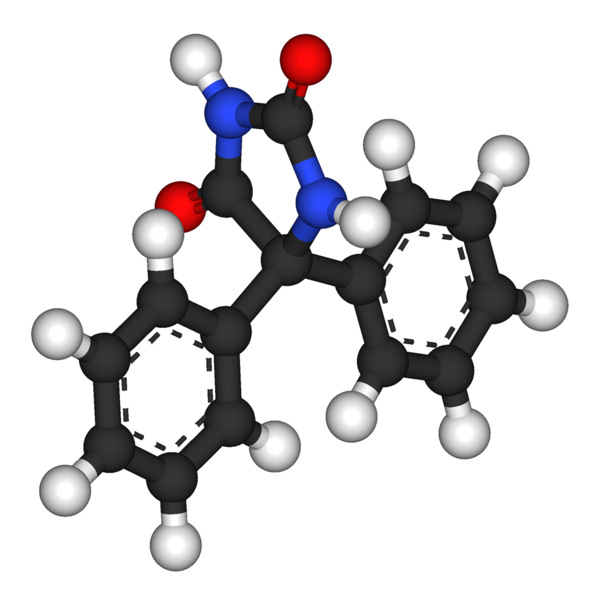Phenytoin detailed information
 | |
 | |
| Clinical data | |
|---|---|
| Pregnancy category |
|
| Routes of administration | Oral, parenteral |
| ATC code | |
| Pharmacokinetic data | |
| Bioavailability | 70-100% oral, 24.4% for rectal and intravenous administration |
| Protein binding | 90% |
| Metabolism | hepatic |
| Elimination half-life | 6-24 hours |
| Excretion | Primarily through the bile, urinary |
| Identifiers | |
| |
| CAS Number | |
| PubChem CID | |
| DrugBank | |
| E number | {{#property:P628}} |
| ECHA InfoCard | {{#property:P2566}}Lua error in Module:EditAtWikidata at line 36: attempt to index field 'wikibase' (a nil value). |
| Chemical and physical data | |
| Formula | C15H12N2O2 |
| Molar mass | 252.268 g/mol |
Editor-In-Chief: C. Michael Gibson, M.S., M.D. [1]
Please Take Over This Page and Apply to be Editor-In-Chief for this topic: There can be one or more than one Editor-In-Chief. You may also apply to be an Associate Editor-In-Chief of one of the subtopics below. Please mail us [2] to indicate your interest in serving either as an Editor-In-Chief of the entire topic or as an Associate Editor-In-Chief for a subtopic. Please be sure to attach your CV and or biographical sketch.
Phenytoin sodium is a commonly used antiepileptic. It was approved by the Food and Drug Administration in 1953 for use in seizures. Phenytoin acts to damp the unwanted, runaway brain activity seen in seizure by reducing electrical conductance among brain cells by stabilizing the inactive state of voltage gated sodium channels. Aside from seizures, it is an option in the treatment of trigeminal neuralgia as well as certain cardiac arrhythmias.
Trade names
Phenytoin sodium has been marketed as Phenytek® by Mylan Laboratories, previously Bertek Pharmaceuticals, and Dilantin®; also Dilantin® Kapseals® and Dilantin® Infatabs® in the USA, Eptoin® by Abbott Group in India and as Epanutin® in the UK and Israel, by Parke-Davis, now part of Pfizer. In the USSR and post-USSR countries, it was/is marketed as Дифенин (Diphenin, Dipheninum), PhydumTM in form of tab./inj. by Quadra labs pvt. ltd. in India.
History
Phenytoin (diphenylhydantoin) was first synthesized by German physician Heinrich Biltz in 1908. Biltz sold his discovery to Parke-Davis, which did not find an immediate use for it. In 1938, outside scientists including H. Houston Merritt and Tracy Putnam discovered phenytoin's usefulness for controlling seizures, without the sedative effects associated with phenobarbital.
According to Goodman and Gilman's Pharmacological Basis of Therapeutics,
- In contrast to the earlier accidental discovery of the antiseizure properties of bromide and phenobarbital, phenytoin was the product of a search among nonsedative structural relatives of phenobarbital for agents capable of suppressing electroshock convulsions in laboratory animals.[1]
There are some indications that phenytoin has other effects, including anxiety control and mood stabilization, although it has never been approved for those purposes by the FDA. Jack Dreyfus, founder of the Dreyfus Fund, became a major proponent of phenytoin as a means to control nervousness and depression when he received a prescription for Dilantin in 1966. Notably, he is believed to have supplied large amounts of the drug to Richard Nixon throughout the late 1960s and early 1970s. Dreyfus' book about his experience with phenytoin, A Remarkable Medicine Has Been Overlooked, sits on the shelves of many physicians courtesy of the work of his foundation. Despite more than $70 million in personal financing, his push to see phenytoin evaluated for alternative uses has had little lasting effect on the medical community. This was partially due to the fact that Parke-Davis was reluctant to invest in a drug nearing the end of its patent life, and partially due to mixed results from various studies.
Dilantin made an appearance in the 1962 novel One Flew Over the Cuckoo's Nest by Ken Kesey, both as an anticonvulsant and as a mechanism to control inmate behavior.
Side-effects
At therapeutic doses, phenytoin produces horizontal gaze nystagmus, which is harmless but occasionally tested for by law enforcement as a marker for alcohol intoxication (which can also produce nystagmus). At toxic doses, patients experience sedation, cerebellar ataxia, and ophthalmoparesis, as well as paradoxical seizures. Idiosyncratic side effects of phenytoin, as with other anticonvulsants, include rash and severe allergic reactions.
It has been suggested that phenytoin causes a reduction in folic acid levels, predisposing patients to megaloblastic anemia. Folic acid is presented as polyglutamate in foods, it is then converted into monoglutamates by intestinal conjugase. Now phenytoin acts by inhibiting this enzyme therefore causing folate deficiency. [2]
There is some evidence that phenytoin is teratogenic, causing what Smith and Jones in their Recognizable Patterns of Human Malformation called the fetal hydantoin syndrome. There is some evidence against this. One blinded trial asked physicians to separate photographs of children into two piles based on whether they showed the so-called characteristic features of this syndrome; it found that physicians were no better at diagnosing the syndrome than would be expected by random chance, calling the very existence of the syndrome into question. Data now being collected by the Epilepsy and Antiepileptic Drug Pregnancy Registry may one day answer this question definitively. The CDC lists fetal hydantoin syndrome as a rule-out for differential diagnosis of Fetal alcohol syndrome due to overlapping facial and intellectual symptoms.[3]
Phenytoin may accumulate in the cerebral cortex over long periods of time, as well as causing atrophy of the cerebellum when administered at chronically high levels. Despite this, the drug has a long history of safe use, making it one of the more popular anti-convulsants prescribed by doctors, and a common "first line of defense" in seizure cases. Phenytoin also commonly causes gingival hyperplasia due to folate deficiency.
Recently phenytoin is suggested to be a human carcinogen. [4]
Due to patent expiration, phenytoin is available in generic form and several branded forms at relatively low cost, making it one of the more affordable seizure control medications. It is available in extended release capsules and injectable forms, though the injectable formulation is rapidly losing ground to fosphenytoin (an important side note is that fosphenytoin has to be dephosphorylated before it can metabolized for use which can take an extra 15 minutes). Some generic formulations of phenytoin have been felt to be less reliable with respect to time-release than their branded counterparts. In some cases, this can be related to complications which arise between the alternative protein bond release mechanisms used in the generic versions, and those individuals with high metabolic rates.
Phenytoin has been associated with drug induced gingival enlargement in the oral cavity. Plasma concentrations needed to induce gingival lesions has not been clearly defined. Effects consist of the following: bleeding upon probing, increased gingival exudate, pronounced gingival inflammatory response to plaque levels, associated in some instances with bone loss but without tooth detachment.
References
- ↑ Goodman and Gilman's Pharmacological Basis of Therapeutics, 10th ed. (New York: McGraw-Hill, 2001).
- ↑ Carl GF, Smith ML. (1995). Phenytoin-folate interactions: differing effects of the sodium salt and the free acid of phenytoin. http://www.ncbi.nlm.nih.gov/entrez/query.fcgi?cmd=Retrieve&db=PubMed&list_uids=1547769&dopt=Abstract.
- ↑ CDC. (2004). Fetal Alcohol Syndrome: Guidelines for Referral and Diagnosis. Can be downloaded at http://www.cdc.gov/fas/faspub.htm.
- ↑ Report on Carcinogens, Eleventh Edition (PB2005-104914, 2004) p III-216.
See also
External links
- Phenytoin American Epilepsy Society.
- Remarkable Medicine, a website about the Dreyfus Foundation's work to expand the indications for phenytoin
- "Fits & Facts". Time Magazine. 1941-11-03. Retrieved 2006-09-05. Check date values in:
|date=(help) – Time Magazine reports in 1941 on a "a promising new drug called sodium diphenyl hydantoinate (Dilantin)".
- Pages with script errors
- E number from Wikidata
- ECHA InfoCard ID from Wikidata
- Articles without EBI source
- Chemical pages without ChemSpiderID
- Articles without KEGG source
- Articles without InChI source
- Articles without UNII source
- Drugs with no legal status
- Articles containing unverified chemical infoboxes
- CS1 errors: dates
- Antiarrhythmic agents
- Anticonvulsants
- Hematology
- Drugs